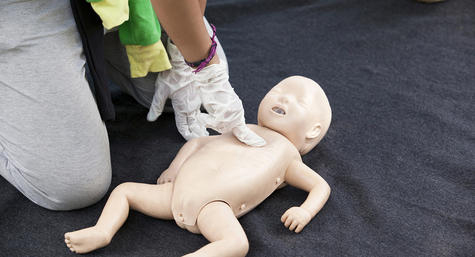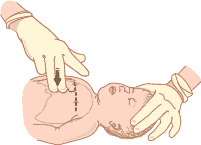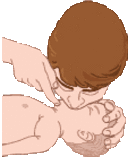
While I am certified to perform CPR for infants, I am not certified to instruct others on how to perform CPR. Instead I am providing another source for you so that you too can come to the rescue, God-forbid, the need ever arise. The Baby Center: Expert Advise section has illustrated guides on first aid and CPR. Read this guide several times and attend a CPR and first aid course provided by a source such as the Red Cross.
How to perform CPR
What is CPR?
CPR stands for cardiopulmonary resuscitation. This is the lifesaving measure you can take to save a baby who shows no signs of life (consciousness or effective breathing).
CPR uses chest compressions and “rescue” breaths to make oxygen-rich blood circulate through the brain and other vital organs until emergency medical personnel arrive. Keeping oxygenated blood circulating helps prevent brain damage – which can occur within a few minutes – and death.
CPR isn’t hard to do. Follow these steps:
Step 1: Check the baby’s condition.
Is the baby conscious? Flick her foot or gently tap on her shoulder and call out. If she doesn’t respond, have someone call 911 or the local emergency number. (If you’re alone with the baby, give two minutes of care as described below, then call 911 yourself.)
Swiftly but gently place the baby on her back on a firm, flat surface.
Make sure she isn’t bleeding severely. If she is, take measures to stop the bleeding by applying pressure to the area. Don’t administer CPR until the bleeding is under control.
Step 2: Open the baby’s airway.
Tilt the baby’s head back with one hand and lift his chin slightly with the other. (You don’t have to tilt a baby’s head back very far to open the airway.)
Check for signs of breathing for no more than ten seconds.
To check for breathing in a baby, put your head down next to his mouth, looking toward his feet. Look to see whether his chest is rising, and listen for breathing sounds. If he’s breathing, you should be able to feel his breath on your cheek.
Step 3: Give two gentle “rescue” breaths.
If the baby isn’t breathing, give her two little breaths, each lasting just one second. Cover the baby’s nose and mouth with your mouth and gently exhale into her lungs only until you see her chest rise, pausing between rescue breaths to let the air flow back out.
Remember that a baby’s lungs are much smaller than yours, so it takes much less than a full breath to fill them. Breathing too hard or too fast can force air into the baby’s stomach.
If her chest doesn’t rise, her airway is blocked. Give her first aid for choking, described above.
Step 4: Do 30 chest compressions.

With the baby still lying on his back, place the pads of two or three fingers in the center of his chest, just below an imaginary line running between his nipples.
With the pads of your fingers on that spot, compress the chest about 1 1/2 inches. Push straight down. Compressions should be smooth, not jerky.
Do 30 chest compressions at the rate of 100 per minute. Count out loud: “One and two and three and…”, pushing down as you say the number and coming up as you say “and.” (The song Staying Alive is the right rate!)
When you complete 30 compressions, give two rescue breaths (step 3, above). (Each cycle of chest compressions and rescue breaths should take about 24 seconds.)
Step 5: Repeat compressions and breaths.

Repeat the sequence of 30 compressions and two breaths. If you’re alone with the baby, call 911 or the local emergency number after two minutes of care.
Continue the sequence of compressions and breaths until help arrives, you find an obvious sign of life, an AED (automated external defibrillator) is ready to use, the scene becomes unsafe, or you are too exhausted to continue.
Even if the baby seems fine by the time help arrives, a doctor will need to check her to make sure that her airway is completely clear and she hasn’t sustained any internal injuries.


Okay, sorry, but this is totally unrelated.
My dog had this little scrape on her leg, and really, it was tiny, but she’s been obsessing over it. She licks it non stop, and now she has no hair on that spot, and it’s starting to get raw. Bitter apple spray only works for about 10 minutes after I spray it, so I was wondering if there are any essential oils or something that tastes really nasty but wouldn’t hurt her? I saw some no-lick spray recipes on line, but they all had vinegar, and that just seems to me like it would sting. She HATES wearing the cone so much, I really don’t want to use it.
LikeLiked by 1 person
No problem, I would mix oregano oil and coconut oil. The oregano oil is a little bit on the horrid side, but is an antibiotic and the coconut oil is antimicrobial and will ensure that it doesn’t sting… eliciting more licking 😉
The other thing is to try to stop the behavior. Put her on a slip lead and keep her with you for about an hour. Every time she attempts to lick her wound, you give a quick correction with the leash with a quick tug and an immediate release. Tug towards your body to throw her off balance and re-direct her focus to your eyes and say “OFF” in a firm, clear tone. Each and every time she attempts to lick, repeat this… She will understand. How old is she?
LikeLiked by 1 person
She’s 9.
She’s a little upset because my mom, who basically IS her sense of security, is out of town, so I think maybe correcting her might freak her out more in this case. The anxiety probably contributes to the licking, but it started before “her mommy” left. But she’s kind of a weirdo anyway, it’s one of those things she does every time she gets a sore spot or something like that.
LikeLiked by 1 person
Anxiety is a difficult thing to deal with in dogs. I’m sure you are right about her behavior. When her mommy is gone, you can also try passionflower (350mg) and skullcap (425mg) up to 3x daily (if she’s a medium-large dog– she’s a pointer?). Both are very, very effective. I worked as an animal behaviorist for many years at a shelter. It should be your mom doing the initial training, correcting these behaviors. Your mom should be very calm when making these corrections – no emotions one way or the other. Then the rest of your family can participate.
LikeLiked by 1 person